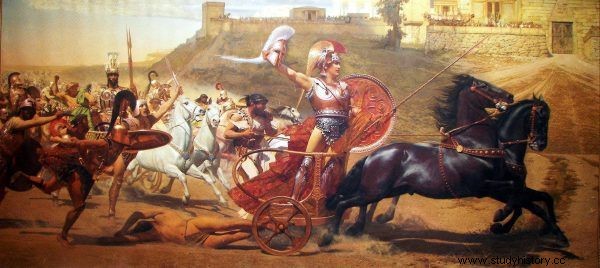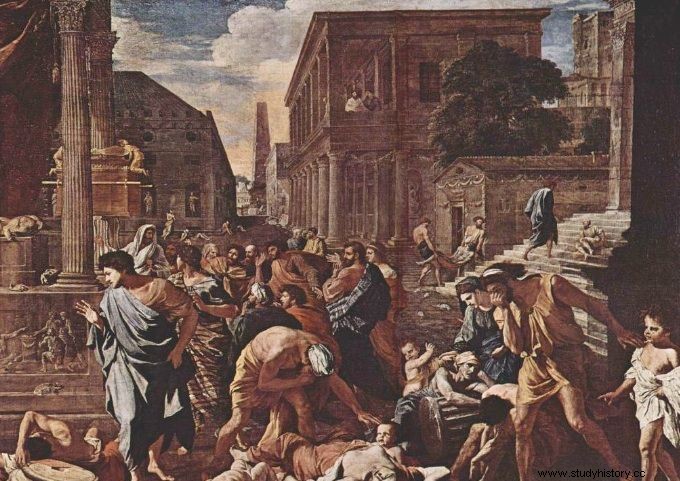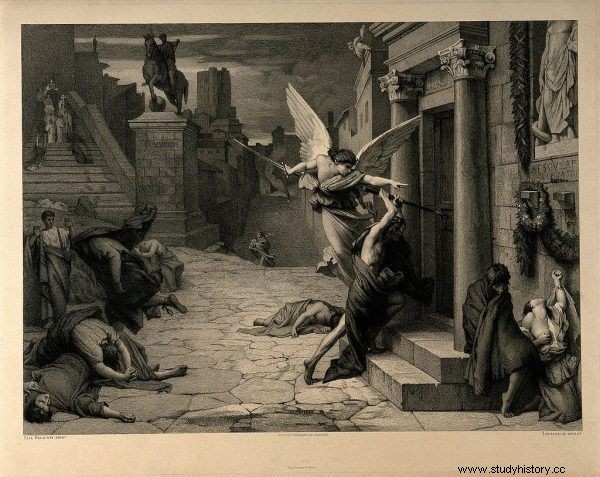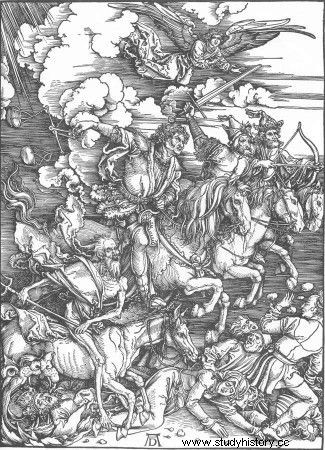They have plagued humanity from the earliest times. They influenced the fate of wars, led to changes in the balance of political forces, and decimated societies. They affected everyone - the poor and the rich, and were equally cruel to everyone. Meet the epidemics of the ancient world.
For the first time in literature, the word epidemic appeared in Homer in "The Iliad", but then it was used in a completely different sense than today. By Homer, this term was understood as "national, homely, home" as evidenced by the fragments of "Iliad", where the epidemic forms part of the phrase "civil war" and "Odyssey", where it was supposed to mean "who returned home".
Epi - "na", demos - "people" - does the ancient epidemic have anything to do with the present day?
Sophocles, who in the drama "Oedipus King" used a word of interest to us to present the "spreading through the country" of the king's fame, was closer to the modern understanding of the epidemic. Sophocles wrote at about the same time as the oldest surviving work of ancient medicine, the Corpus Hippocraticum by Hippocrates.

From the "Iliad" we learn that the troops besieging Troy were struggling with the prevailing plague
The concept of an epidemic closest to the present meaning of this word was not recorded until Roman times in the 4th century CE. in Ammian Marcellinus in his book "The History of Rome".
The first type of plague is called a pandemic - it causes the lives of the inhabitants of drier areas to be interrupted by their often haunting fever, the second type - epidemic, occurs seasonally, reduces visual acuity and causes a dangerous accumulation of moisture "
It should be mentioned, however, that the word epidemic was not the most frequently used word in ancient literature. The word pestilentia was more often used to describe plague in Roman times . In the preserved books of the work of Titus Livius Ab urbe condita libri ("Since the founding of Rome"), the term has appeared several times in reference to the epidemics plaguing Rome. In the propaganda of Emperor Claudius, however, this concept was changed into the term morbus meaning plague.
Plagued by the plague
From Titus Livius we learn that during the times of the Republic, Rome was plagued by plagues nine times. Pliny the Elder also mentions new diseases on a massive scale. Suetonius also refers to the plague that took place after the eruption of Vesuvius, while praising the merits of Emperor Titus who, in this difficult time, showed great care and "paternal solicitude" towards his subjects.
Another plague struck Rome in AD 249-268. and although we do not know the details of its course, the source texts mention coexisting wars and hunger as the causes of all diseases. Eusebius of Caesarea in "The Church's History" drew attention to the fact that the piles of corpses in the rivers are responsible for the plagues that still haunt humanity.
Cause of military disasters
Outbreaks of infectious diseases often made military operations difficult or impossible. They contributed to the loss of great battles, led to huge losses in the ranks of the soldiers, and even stopped military campaigns. We learn from Homer in "The Iliad" that the troops besieging Troy were affected by the plague that first killed animals and then passed on to humans.
The oldest plague known to us was the trichinella epidemic, which spread among the Carthaginians sent to war with Sicily in 422 BCE. This disease is caused by Trichinella spiralis larvae . Infection with these parasites occurs as a result of eating meat infected with them.

In the ancient era, plagues very often hit the population
One of the most famous epidemics of the ancient world is the Peloponnesian Plague. Just before the outbreak of the war with Sparta, Pericles persuaded the Athenians to move to Athens with all their belongings. In 430 B.C.E. a great plague broke out in besieged Athens. We learn about her from Thucydides, who described her as an eyewitness and one of the sick in the Peloponnesian War.
The first symptoms of the disease were high fever, anxiety and insomnia. Then the eyes, tongue and mouth filled with blood. With time, the symptoms became hoarse and runny nose. When the patient's lungs were infected, a strong cough occurred, and if the disease attacked the stomach, it was associated with severe vomiting. Thucydides also mentions that although the bodies of the infected were not visibly warm, the patients themselves were not even covered with light materials. They felt so hot and their bodies burned them so badly that they dreamed of jumping naked into cold water.
The disease killed those infected within seven to nine days of onset of symptoms. The survivors bore the stigma of the disease forever in the form of loss of limbs or organs. Interestingly, even carnivorous animals did not approach the corpses of people who died during this plague. Modern research based on DNA analysis suggests that it could have been infected with Salmonella typhi causing typhoid fever.
As a consequence of the epidemic, Athens suffered a more severe defeat as almost every fourth Athenian soldier died during it. Pericles himself also died. Greece remained scattered, and several decades later, Philip II entered the Greek lands.
The decimation of soldiers also took place during the Marcomannic wars. After the victory over the Parthians, Marcus Aurelius' army was attacked by a mysterious plague - most likely smallpox or measles. The army then transferred the disease to Rome, where it spread throughout the city. It is estimated that between 5 and 7 million people died during this epidemic. For comparison, during the Battle of Adrianople, described as one of the bloodiest clashes in ancient Rome, about 20,000 soldiers were killed in one day. Viruses therefore turned out to be much more deadly than the barbaric tribes.

During the Antoninov Plague, the bodies of the sick were covered with ulcers and suffered from high fever
This epidemic went down in history under the name of the Antoninus Plague or the Galenic Plague, because it is from his messages that we learn about its outbreak. Thanks to him, we know the symptoms of the disease that hit Rome. There was a black rash on the body in the form of ulcers. The disease was not accompanied by temperature, but all patients suffered from diarrhea, some also struggled with vomiting, stomach pains and coughing. The most dangerous days were between 9 and 12 after the onset of symptoms. Most often, when the blisters on the body hardened, dried up and fell off, patients began to heal.
Due to the many deaths and the fear of the further spread of the plague, a law regulating burials and the rules for erecting tombs near houses were also established during this period.
The plague also accompanied the war with the Scythians. And in this case, it turned out that the fight against the barbarians caused less damage to people than the accompanying epidemic. Its advent was heralded by war disasters and earthquakes. Many cities were flooded by the sea at that time. The epidemic spread to the Latin and Greek areas of the Roman Empire. According to the description of Cyprian of Carthage, the disease started with stomach problems and wounds in the throat. As a result, the patient then developed high fever, vomiting, and his eyes became red with blood. The sick were unable to move freely (many of them had their limbs amputated at that time), they systematically lost their hearing and went blind. The Scythians tried to ravage the cities of the empire, but were stopped as both armies suffered from the same plague. Thus, once again, the disease thwarted the war plans.

Epidemics and plagues have influenced the fate of the world many times.
Many times throughout history, outbreaks have become the cause of failed military operations and wars. It was no different in antiquity. They led to the fall of Athens or Carthage, stopped Alexander of Macedon from going to India, and even contributed to the fall of Rome. The ancients were unaware of the cause of the plague and fought it often in the dark. Diseases could take everyone with them, regardless of property status or fame. If they only knew how often they should wash their hands…
Literature:
- E. Bugaj, Plague in the Roman world in the times of the Antonines , [in:] W. Dzieduszycki, J. Wrzesiński, Epidemics, disasters and wars , "Scientific Association of Polish Archaeologists", Poznań Branch, 2008, pp. 80-114.
- K. Harper, The Fate of Rome:Climate, Disease, and the End of an Empire , Princeton University Press 2017.
- J. Iwańska, Epidemics in ancient Greek and Roman sources , SEMINARE, vol. 30, 2011, pp. 209-221.
- J. Iwańska, The meaning of the term epidemic in ancient Greco-Roman literature. An attempt to analyze on selected examples , SEMINARE, vol. 35, 2014, no. 4, pp. 175-184.
